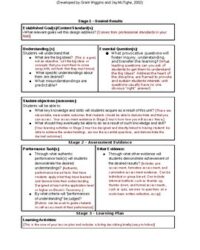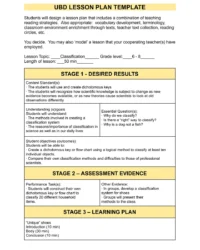In the dynamic world of education, effective planning is the bedrock of successful teaching and meaningful student learning. Gone are the days of simply opening a textbook and teaching chapter by chapter. Today’s educators are increasingly turning to more robust, student-centered frameworks that ensure clarity, purpose, and genuine understanding. One such powerful approach is Understanding by Design, or UBD.
A well-structured ubd lesson plan template serves as your guiding star, helping you design lessons that are not just comprehensive but also deeply engaging and impactful. It shifts the focus from what you will teach to what students will understand and be able to do as a result of your teaching. This backward approach, which we’ll explore in detail, ensures every lesson component serves a clear purpose, leading to more coherent and effective learning experiences for everyone in the classroom.
Unpacking the “Backward Design” Philosophy
The core of Understanding by Design, and thus any good UBD lesson plan template, lies in its “backward design” philosophy. Instead of starting with activities or content and hoping students grasp key concepts, UBD encourages you to begin with the end in mind. You identify the desired results first, then determine acceptable evidence that learning has occurred, and only then do you plan the learning experiences and instruction. This logical flow ensures that all teaching efforts are strategically aligned with specific learning goals, fostering deeper understanding rather than rote memorization.
Stage 1 of backward design is all about identifying those desired results. What enduring understandings do you want students to grasp? What essential questions will provoke their inquiry and stimulate thought? What specific knowledge and skills should they acquire? This initial phase demands clarity and a deep dive into the curriculum, moving beyond just listing topics to defining what truly matters for students to learn and carry with them beyond the classroom.
Once you’ve pinpointed the desired results, Stage 2 focuses on determining acceptable evidence. This is where you design assessments that will genuinely reveal whether students have achieved the targeted understandings and proficiencies. It’s not just about traditional tests; it encompasses a variety of assessment methods, including performance tasks, quizzes, observations, and student self-assessments. The key is to think like an assessor before you think like an instructor, ensuring your assessments truly measure what you intend for students to learn.
Finally, in Stage 3, you plan the learning experiences and instruction. With a clear understanding of your goals and how you’ll assess them, you can now craft engaging activities, select relevant resources, and design teaching strategies that will help students acquire the necessary knowledge and skills, ultimately leading them towards the desired results. This stage is where creativity and pedagogical expertise come into play, building a bridge between where students are now and where you want them to be.
Why UBD Stands Out
UBD’s structured approach brings unparalleled clarity to lesson planning. It ensures that every activity, every discussion, and every piece of content contributes directly to the overarching learning objectives. This clarity not only benefits the teacher by providing a clear roadmap but also empowers students, as they understand the purpose behind their learning and how each task connects to the bigger picture. It promotes deeper understanding and the ability to transfer knowledge to new situations, which are crucial skills in today’s complex world.
Key Elements of a Comprehensive Template
A good ubd lesson plan template will typically guide you through these stages with dedicated sections. It provides a scaffold that helps organize your thoughts and ensures you don’t miss crucial steps. While specific layouts might vary, the core components remain consistent, reflecting the three stages of backward design. It’s a tool that simplifies complexity, making the planning process more manageable and effective.
- Desired Results: Clearly outlining established goals, essential questions that will drive inquiry, and the enduring understandings students should achieve.
- Assessment Evidence: Detailing performance tasks and other evidence that will demonstrate student understanding and proficiency.
- Learning Plan: Describing the sequence of learning activities, materials, and instructional strategies, including differentiation for diverse learners.
Practical Application: Getting Started with Your UBD Lesson Plan Template
Adopting a UBD lesson plan template doesn’t have to be an overwhelming overhaul of your teaching practice. Many educators find it most effective to start small, perhaps by designing one unit or a particularly challenging lesson using the UBD framework. The beauty of a template is that it provides a structured canvas; you fill in the details based on your specific curriculum, student needs, and teaching style. It encourages you to think critically about the “why” before the “what” or “how,” leading to more intentional and purposeful instruction from the outset.
As you become more familiar with the stages, you’ll find that the process becomes more intuitive. It fosters a mindset of continuous improvement, prompting you to reflect on whether your assessments truly align with your desired results and if your learning activities effectively prepare students to demonstrate their understanding. This reflective practice is key to refining your lessons over time, making them increasingly effective and responsive to student progress.
Ultimately, a UBD lesson plan template is more than just a document; it’s a tool for transforming your pedagogical approach. It shifts the emphasis from simply covering content to ensuring students truly grasp and can apply essential concepts. By consistently using this framework, you’re not just planning lessons; you’re designing rich, meaningful learning experiences that stick with students long after the unit is over. It’s a proactive step towards cultivating deeper understanding and fostering lifelong learners.
- Begin with clarity: What do you truly want students to know and be able to do by the end of the lesson or unit?
- Think like an assessor: How will you know if they’ve achieved those desired results? What evidence will you look for?
- Design engaging learning: What experiences, activities, and resources will effectively lead students to that evidence and understanding?
- Refine and reflect: Is the plan coherent? Does it truly align? Are there opportunities for differentiation and formative feedback?
Embracing a structured approach to lesson design offers profound benefits, leading to more focused teaching and more impactful learning outcomes. It encourages educators to step back, define the ultimate destination, and then meticulously chart the course, ensuring that every step taken by students is purposeful and leads toward genuine understanding. This thoughtful planning process not only enhances student achievement but also brings greater clarity and satisfaction to the teaching profession itself.
By consistently applying these principles, you empower your students to not just learn facts but to truly comprehend concepts, apply knowledge, and transfer skills. It’s about building a solid foundation for future learning, equipping them with the tools they need to succeed academically and beyond. The effort invested in this thoughtful design process pays dividends in the form of deeper engagement, richer discussions, and a more profound educational experience for everyone involved.


